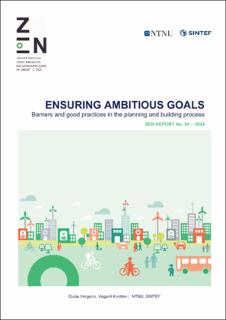| dc.description.abstract | Barriers and good practices in ambitious projects
How can we ensure good processes before, during and after the realization of a zero-emission area? How can we ensure that buildings are realized as intended? Why do we struggle with good intentions being lost in the process from early planning to completed construction?
With this report, we want to collect key findings from the literature in terms of barriers, challenges, best practices, and drivers in pursuing ZEN-like projects. The focus is on building processes in the context of projects with ambitious energy and environmental targets.
In the context of energy-efficient projects, hidden costs, split incentives, and inertia, are only a few of the constraints that ambitious projects must deal with, together with a lack of accountability of the actors after delivery, lack of knowledge and skills, poor communication and collaboration, lack of life cycle thinking, etc. They ultimately cause a gap between ambitions and actual delivery. Clear goals formulation, collaboration, closeness, involvement of stakeholders, and shared understanding/acceptance of the concept of Zero Emission Buildings by actors were some of the success factors in the pilots of the Research Centre on Zero Emission Buildings. However, the complexity rises significantly when we move to the district scale (like we do in the Research Centre on Zero Emission Neighbourhoods). Conceiving the development as a program of projects with a central coordinator seems a promising way forward to tackle the challenge of building carbon-neutral neighbourhoods. Many challenges persist, including uncertainties, interests mismatches, lack of knowledge of technical requirements and management processes.
The success of a project in terms of goal achievement is strictly related to a successful process. With the adoption of integrated design and Soft Landings strategies, the literature suggests the importance of collaboration, improvement of information flow, the rise of actors’ accountability in the aftercare, and acknowledgement of the users’ and Facility Manager’s perspectives since the design stage. With commissioning, they have the potential to bridge the gap between design goals/ambitions and the operational status of a building, delivering actual benefits. Their maintenance might also require new actors in the urban panorama (i.e., urban Facility Managers).
Organizational, contractual, and cultural aspects should then be revised and improved to build the proper environment for a project's success, deploying new tools and methods. Tools to enhance projects’ goals include quality assurance methods, early-stage simulation tools, information technologies, and extended reality technologies. With organizational strategies (e.g., Lean principles) and suitable contractual arrangements, they should support performance-based design and integrated project delivery, including integrated risk management, as a measure to ensure project success in terms of goal achievement.
In the fragmented and project-based Architecture, Engineering and Construction industry the adoption of tools is under its full potential because of technical, but also non-technical reasons. Most importantly, collaboration is still hindered, since diverse actors are coming together for a limited amount of time, with their own cultures, practices, and objectives. Lack of stakeholders’ collaboration and commitment, insufficient organizational processes, and unsupportive development frameworks are reasons for failure in reaching energy master plan goals at the neighbourhood level more than lack of technologies. Thus, the literature suggests that to increase the opportunities for a project’s success, the following actions/elements, among others, should be promoted:
• Exploration and implementation of collaborative frameworks and tools (including digital),
• Demanding and knowledgeable clients pursuing and following-up on ambitious goals under fair contract arrangements,
• Long-term relationships between actors to build trust and a ‘no-blame’ culture,
• Championing,
• Contracts as management tools,
• Early involvement of contractors and suppliers,
• Users’ involvement,
• Increasing knowledge across industries,
• Sharing of knowledge, information, risks, and rewards,
• Life cycle thinking and performance assessment tools,
• Building and maintenance of a project culture,
• Improvement of experts’ communication,
• Implementation of tools/practices to reduce conflicts.
Tools/recommendations are needed to untap the potential for integrated approaches in ZEN developments, and stakeholders’ engagement must be guaranteed by carefully evaluating and managing goals, values, and risks. | en_US |
